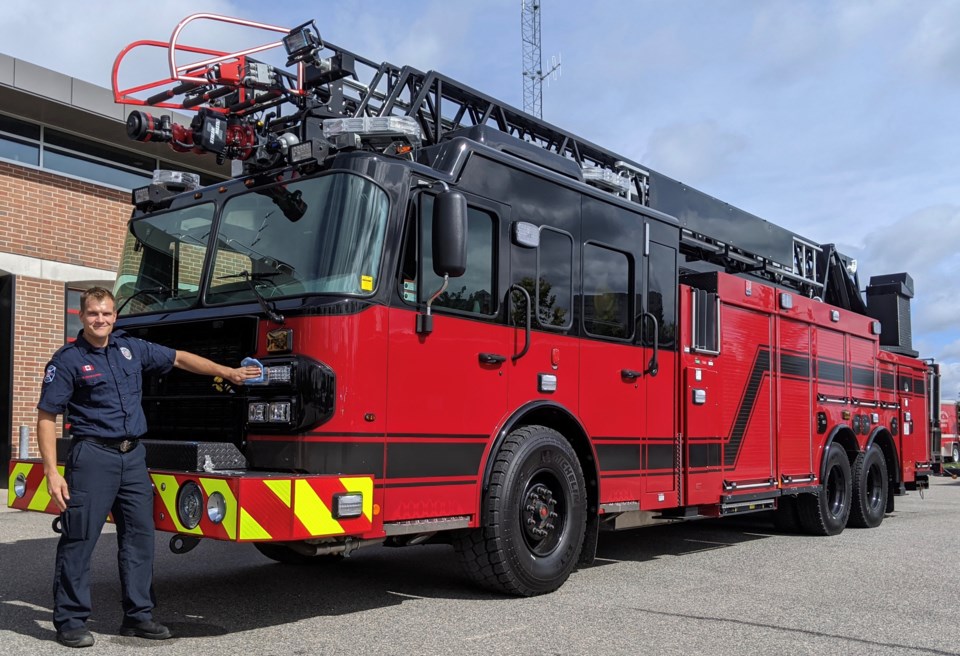Barrie has one of its two new aerial fire trucks, with another one on the way along with a rescue truck.
“They’re not additional vehicles, they’re the scheduled replacement for vehicles going out of service,” Fire Chief Cory Mainprize said. “Both of them (the aerials) have been received by the dealer, in Mississauga, and we brought one here. It’s being fitted right now, then it will go into service. The next one will probably be here next week. I think it’s ready to be delivered.
"We don’t want them both at the same time, because there’s so much work to do on them once they get here," the chief added. “We schedule them a couple of weeks apart, so we can get the work completed on them.”
Mainprize said radios have to be installed, along with the greasing systems, all the logos and stickers need to be applied and then the chargers, flashlights and air-monitoring equipment. He also said final inspection of the rescue truck is taking place Tuesday in Nebraska.
The aerial trucks are each worth approximately $1.8 million (Cdn.), while the rescue truck is around $1.2 million.
“We literally just got the invoices this week,” Mainprize said. “The exchange (rate) is not great right now. And we got lucky, we locked in the contract about 18 months ago, which actually resulted in significant savings.”
In 2023, Barrie Fire and Emergency Service will receive one HazMat (hazardous materials) truck and two rescue trucks.
At about the 10- to 12-year mark, fire trucks start to go on reserve status and then, depending on use, they can go another five to seven years in reserve status, but at 20 years they’re considered done.
“When the cost to maintain them exceeds a certain threshold of the value of the vehicle, we’ll look to replace them sooner,” Mainprize said.
Barrie has five fire stations — Station No. 1 at 155 Dunlop St. W. has a pumper, a rescue and an aerial truck, Station No. 2 at 15 Bell Farm Rd. has a rescue truck, Station No. 3 at 340 Big Bay Point Rd. has an aerial truck, Station No. 4 at 250 Ardagh Rd. has a pumper truck, and Station No. 5 at 360 King St. has a rescue truck.
“They can all pump water, they all have hose lines,” Mainprize said. “The difference with the rescue truck is they’re just a little bit longer so it gives us the ability to carry additional equipment for vehicle extrication.
“And we stagger those (rescue trucks) — one in the north, one in the south and then one in the middle of the city," he added.
Station No. 6, meanwhile, is planned at the southwest corner of Prince William Way and Mapleview Drive, and is to be operational in the spring of 2024. Construction would start mid-2023, and it will take eight to 10 months to build.
Barrie’s new aerial trucks have ladders of 105 feet — the old towers are 100 feet — but Mainprize said this will make no difference if firefighters are called to any of the city's highrise buildings.
“Aerials are not generally used for highrise firefighting,” he said. “And the height of the buildings often well exceeds the reach of an aerial anyway. They’re generally designed for water application from an elevated position.
“Rescues with aerial ladders are very, very rare. Highrise fires are fought from the inside out, not from the outside in, so you have to move equipment and staffing throughout the building using the elevators or the staircase," the chief added.
Mainprize said New York City has the same size aerial ladders as Barrie, and that most ladders in North America are 85 to 110 feet in size.
“We have two aerials in service at any given time and we have a spare,” he said. “One of them will be going out of service. It’s 20 years old. That one will be decommissioned and be leaving. Two new ones will go in service, and one will be a spare.”



